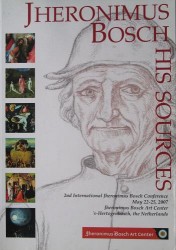
Marías 2010
“Bosch and Dracontius’ De Creatione Mundi Hexameron” (Fernando Marías) 2010
[in: Eric De Bruyn and Jos Koldeweij (eds.), Jheronimus Bosch. His Sources. 2nd International Jheronimus Bosch Conference, May 22-25, 2007, Jheronimus Bosch Art Center, ’s-Hertogenbosch, the Netherlands. Jheronimus Bosch Art Center, ’s-Hertogenbosch, 2010, pp. 246-263]
Until 1615 the ’s-Hertogenbosch St. John’s Cathedral was the location of a triptych by Jheronimus Bosch, which was called an opus creationis hexameron mundi (work about the the creation of the world in six days) in a chronicle from 1606/1609. This work may have been another version of Bosch’s Garden of Earthly Delights. This brings us to the hexameral literary tradition in which sometimes odd topics and themes were treated, such as the question how life would have been in an overpopulated Garden of Eden since there was no death. Peter S. Beagle (1982), Hans Belting (2002) and Juan Antonio Ramirez (2005) have suggested that the central panel of Bosch’s Garden triptych represents Earthly Paradise like it could have been had there not been sin. Marías agrees with these authors and focuses on Blossius Aemilius Dracontius’ De creatione mundi Hexameron, a work written around 496 and often considered to be a text by St. Augustine, even after it was rediscovered by Nicolaus Cusanus in the fifteenth century.
The first and the third book of this text are a poetic gloss of Genesis exuding a lyrical and even sensual character in some of their passages. Marías quotes a number of these passages, seeing a relationship between what Dracontius wrote and the closed wings of Bosch’s Garden (a globe in the middle of the celestial space), the aggressive animals, the gems and the institution of marriage on the left panel and the world without disease, death, decay, elderly or children on the central panel. According to Marías Bosch wanted to depict a potential past, a lost opportunity on the central panel of the Garden: Earthly Paradise as it could have been if the Fall of Man had not occurred. It is possible that Dracontius’ writings contributed to the imagination of Bosch and his clients which is why we should keep on studying this hexameral literature.
Marías’ starting point is strongly based on hypothesis: it is by no means certain that the triptych in the Bosch cathedral can be identified as another version of the Garden of Delights. Furthermore the Dracontius passages he quotes do show a vague resemblance to what Bosch painted on the Garden triptych, but none of them is convincing enough to suggest that Bosch was influenced by Dracontius.
[explicit 31st July 2012]